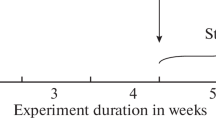Summary
9 young normal subjects were studied during two types of prolonged intermittent exercise requiring periods of heavy work (12 min at 80%\(\dot V_{O_2 }\) max.) alternating with intervening rest periods (for 18 min) in first type and light work (18 min about 40%\(\dot V_{O_2 }\) max.) in second type. In a third experiment, heavy exercise was repeated after 1 hr of rest and followed by light exercise. Hemodynamic variables and body temperature (oesophageal) were measured sequentially.
Prolonged intermittent work was characterized by progressive increase in heart rate, fall in stroke volume and mean brachial pressure while cardiac output remained constant. These variations occurred more rapidly when rest periods were replaced by light work. They were attended by a progressive rise in body temperature. Heart rate closely correlated with oesophageal temperature during prolonged intermittent exercise (r from 0.90 to 0.96). When resting period was extended to 1 hr, subsequent heavy exercise initiates the same hemodynamic and temperature responses. After heavy exercise, light exercise was performed with higher heart rate and oesophageal temperature and lower stroke volume.
Drift in body temperature with prolonged intermittent exercise could be partly responsible for hemodynamic changes by means of redistribution of blood volume and flow to the skin.
Relationship between exercise body temperature and percentage of\(\dot V_{O_2 }\) max. is modified by repeating exercise after a short recovery period.
Similar content being viewed by others
References
Burkart, F., Barold, S., Sowton, E.: Hemodynamic effects of repeated exercise. Amer. J. Cardiol.20, 509–515 (1967).
Christensen, E. H.: Beiträge zur Physiologie schwerer körperlicher Arbeit. IV. Die Pulsfrequenz während und unmittelbar nach schwerer körperlicher Arbeit. Arbeitsphysiologie4, 453–469 (1931).
Cobb, L. A., Johnson, W. P.: Hemodynamic relationships of anaerobic metabolism and plasma free fatty acids during prolonged, strenuous exercise in trained and untrained subjects. J. clin. Invest.42, 800–810 (1963).
Ekelund, L. G.: Circulatory and respiratory adaptation during prolonged exercise in the supine position. Acta physiol. scand.68, 382–396 (1966).
Ekelund, L. G.: Circulatory and respiratory adaptation during prolonged exercise of moderate intensity in the sitting position. Acta physiol. scand.69, 327–340 (1967a).
Ekelund, L. G.: Circulatory and respiratory adaptation during prolonged exercise. Acta physiol. scand.70, Suppl.292, 1–38 (1967b).
Ekelund, L. G., Holmgren, A.: Circulatory and respiratory adaptation during long term, non steady state exercise, in the sitting position. Acta physiol. scand.62, 240–255 (1964).
Fleisch, A.: New methods of stuying gaseous exchange and pulmonary function. Springfield (Ill.): Thomas 1960.
Gerin-Portier, N., Bourgeois, J., Brasseur, L.: Interpretation of gas-blood ratio inP O2 polarography. Pflügers Arch. ges. Physiol.314, 263–273 (1970).
Grandjean, T., Enrico, J. F., Poli, S., Perret, C.: Soins intensifs et surveillance automatique continue de la pression artérielle. Presse méd.77, 571–574 (1969).
Grimby, G., Nilsson, N. J., Sanne, H.: Repeated serial determination of cardiac output during 30 min exercise. J. appl. Physiol.21, 1750–1756 (1966).
Hardy, J. D.: Physiology of temperature regulation. Physiol. Rev.41, 521–606 (1961).
Hartley, L. H., Saltin, B.: Reduction of stroke volume and increase in heart rate after a previous heavier submaximal work load. Scand. J. clin. Lab. Invest.22, 217–232 (1968).
Kelman, G. R.: Digital computer substantive for the conversion of oxygen tension into saturation. J. appl. Physiol.21, 1375–1376 (1966).
Kitzing, J., Kutta, D., Bleichert, A.: Temperaturregulation bei langdauernder schwerer körperlicher Arbeit. Pflügers Arch. ges. Physiol.301, 241–253 (1968).
Nielsen, B., Nielsen, M.: Body temperature during work at different environmental temperatures. Acta physiol. scand.56, 120–129 (1962).
Pirnay, F., Petit, J. M., Bottin, R., Deroanne, R., Juchmes, J., Belge, J.: Comparaison de deux méthodes de mesure de la consommation maximum d'oxygène. Int. Z. angew. Physiol.23, 203–211 (1966).
Rowell, L. B., Brengelmann, G. L., Detry, J.-M. R., Wyss, C.: Venomotor responses to rapid changes in skin temperature in exercising man. J. appl. Physiol.30, 64–71 (1971a).
Rowell, L. B., Brengelmann, G. L., Detry, J. M. R., Wyss, C.: Venomotor responses to local and general thermal stimuli to skin in exercising man. J. appl. Physiol.30, 72–77 (1971b).
Rowell, L. B., Marx, H. J., Bruce, R. A., Conn, R. D., Kusumi, F.: Reductions in cardiac output, central blood volume and stroke volume with thermal stress in normal men during exercise. J. clin. Invest.45, 1801–1816 (1966).
Rowell, L. B., Murray, J. A., Brengelmann, G. L., Kraning, K. K.: Human cardiovascular adjustments to rapid changes in skin temperature during exercise. Circulat. Res.24, 711–724 (1969).
Saltin, B., Hermansen, L.: Esophageal, rectal and muscle temperature during exercise. J. appl. Physiol.21, 1757–1762 (1966).
Saltin, B., Stenberg, J.: Circulatory response to prolonged severe exercise. J. appl. Physiol.19, 833–838 (1964).
Scholander, P. F.: Analyser for accurate estimation of respiratory gases in one-half cubic centimeter samples. J. biol. Chem.167, 235–250 (1947).
Sowton, E., Burkart, F.: Hemodynamic changes during continuous exercise. Brit. Heart J.29, 770–774 (1967).
Thauer, R.: Circulatory adjustments to climatic requirements. In: Handbook of physiology - Section 2: Circulation, Vol. III, pp. 1921–1966. Washington, D. C.: American Physiological Society 1965.
Webb-Peploe, M. M., Shepherd, J. T.: Response of dog's cutaneous veins to local and central temperature changes. Circulat. Res.23, 693–699 (1968).
Williams, C. G., Bredell, G. A. G., Wyndham, C. H., Strydom, N. B., Morrison, J. G., Peter, J., Fleming, P. W., Ward, J. S.: Circulatory and metabolic reactions to work in heat. J. appl. Physiol.17, 625–638 (1962).
Zijlstra, W. G., Mook, G. A.: Medical reflection photometry. Assen: VanGorcum Ltd. 1962.
Author information
Authors and Affiliations
Additional information
This investigation was supported by a grant from the European Community for Coal and Steel (6242-22-55/56).
Rights and permissions
About this article
Cite this article
Detry, JM.R., Gerin, M.G., Charlier, A.A. et al. Hemodynamic and thermal aspects of prolonged intermittent exercise. Int. Z. Angew. Physiol. Einschl. Arbeitsphysiol. 30, 171–185 (1972). https://doi.org/10.1007/BF00699118
Received:
Issue Date:
DOI: https://doi.org/10.1007/BF00699118




